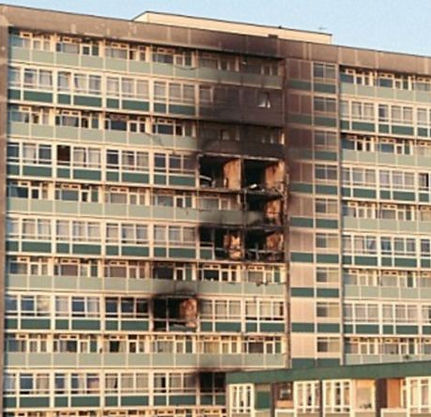Lakanal
House
In July 2009 six people died in the fire at Lakanal House in the London Borough of Southwark. It was the worst fire in a postwar block of flats. The block was 14 storeys tall on a two storey podium and contained 98 flats. The block had only one staircase and no sprinklers. On the day of the fire the Firefighter’s Lift in the entrance lobby was out of action. This lobby had a metal plate on the wall with details of which flats were on which floors. The Firefighters had to use the escape stairs, carrying up heavy hoses etc while people were escaping. As this was an escape stair there was no panel at the bottom to indicate which floors the flats were on. Firefighters had to mentally count the floors and they used up valuable air in their breathing apparatus as they climbed the stairs.



During the last pre-inquest hearing in 2012 the coroner Judge Frances Kirkham announced she would take no evidence on the Firefighter’s lift being out of order on the day of the fire. This was the first time the majority of the people in the inquest, including the legal team for the families of the deceased, knew of this. Five days before the inquest started, the last remaining part of s20 of the London Building Acts (Amendment) Act 1939 was repealed. This part of s20 was the responsibility of the London Fire Brigade and it covered the Firefighter’s Lift.
Furthermore, the block breached the Building Regulations: tower block flats should be able to contain a fire for one hour so that the fire fighters can get to the blaze and put it out before it spreads. This is why the Regulations and Codes of Practice include a ‘stay put’ policy for tenants and residents. It is not intended that people will need to escape their homes, down the only staircase, while the fire-fighters struggle up with their hoses.
This fire was described in the Inquest as having moved very quickly and in unexpected ways. Within 15-20 minutes it had spread both up and down to other floors. Compartmentalisation had been breached, the stay put policy was dangerously inappropriate. The inquest found that people were told to stay in their flats and that some did not know about escape routes along communal balconies. Some firefighters, unfamiliar with the building, did not realise that the flats were maisonettes and on two floors.
"Around 1986 and with the abolition of the GLC, the London Building Acts were repealed, except for the part of s20 mentioned above. From that date Southwark were responsible for enforcing the building regulations. It was something they singularly failed to do on their own buildings. New heating mains were run along the ceiling of the main access /means of escape corridor. These were concealed by a timber false ceiling 60m long by 1.5m wide and 60cm deep. The fire in flat 79 on the 11th floor entered this false ceiling. The walls below had 10 or more coats of oil based paint on the wall and these had been coated with a Class 0 coating to limit spread of flame. When the front door of flat 79 failed, the wall of super heated air which burst into the corridor, with a temperature of 1,000C, melted the underlying coats of paint and these slid down the wall and burst into flames, resulting in a horizontal flame 10m long shooting out of the window at the north end of the corridor like a, “blast furnace” according to firefighters on a aerial escape” explains Sam Webb, architect and expert witness for the families of the deceased.
The 10 week 50 day inquest found that during refurbishments carried out in the block in the 1980s fire stopping materials between flats and communal areas had been removed; new windows had been installed which were made from flammable materials and burnt through in less than five minutes. These factors had, according to the Inquest, significantly contributed to the deaths. The coroner, Judge Frances Kirkham, wrote to the local council and to the government, to the Fire Brigade and Fire Sector Federation to express her concerns. She reported that the Building Regulations on Fire Safety were almost impossible to understand and needed to be reviewed. She was also concerned about the training of fire risk assessors and about the guidance relating to carrying out a fire risk assessment. Southwark had not carried out any Fire Risk Assessments since it had become their responsibility in 2006. Judge Kirkham also recommended that the London Fire Brigade visit blocks to familiarise themselves with the layout and that tenants and residents be given better fire safety information.
Judge Kirkham also recommended that tower blocks landlords consider fitting sprinklers, she had listened to and considered the experience of fire experts that where there are sprinklers there will be no deaths from fire or smoke.







_edited_edited.png)
